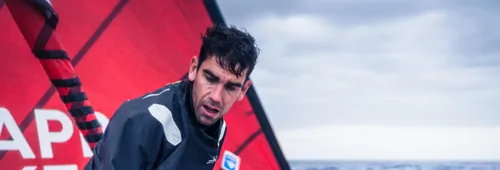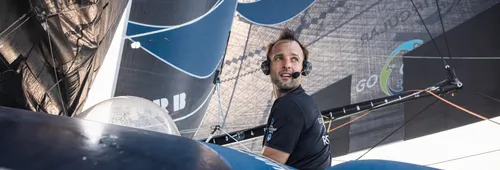The AEZ is moved south
"The wind will be strong but also very gusty. We will have to go fast in a sea that will build It will be quite intense", said Simon who hopes to take advantage of the winds generated by the tightly packed low for as long as possible before being overtaken by it and then gybing towards the South to avoid being caught by the rebuilding Saint Helena anticyclone. But their route is opened as Race Management has chosen to reduce the Antarctic Exclusion Zone (AEZ), this imaginary ring fence drawn around the Antarctic continent (drawn by 72 GPS points separated by 5° each) prohibited to skippers for their safety.
A double advantage
What motivated this decision? "At the time of the start and during the first days of the race, CLS which provides the Vendée Globe with its expertise in processing radar and altimetric satellite data and in modelling ocean currents to detect the presence and predict the drift of icebergs, had reported echoes close to the zone. Since then, new satellite images have made it possible to identify these echoes are fishing boats and in fact the icebergs and growlers are located quite far away. We have decided to reduce the AEZ by almost 100 miles to the Crozets archipelago,” explained Fabien Delahaye who could, with the other members of the Race Direction team, decided in time, to also change this zone after the Kerguelen Islands.
“This change will allow us to start the Indian Ocean well but also shorten the theoretical route a little,” enthused Sébastien Simon echoing the thoughts of most competitors- even if most of them are thinking of other things right now.
For those who have fallen off the back of the train the conditions suddenly become very turbulent in terms of unsettled, shifting winds and seas:
“Unlike the boats in front who are ahead of the depression, we are just behind. So we are suffering a little from its torments but we are making progress,” commented Louis Burton (Bureau Vallée) who is unhappy not to be up with the leaders.
Hare hits the buffers
Pip Hare in 16th on Medallia found the conditions tough last night, dropping suddenly out of the wind band to be caught under a cloud. He somewhat random course for a few hours gave some cause for concern but she explained, “I had a pretty calamitous night. We are sailing along next to a massive front just to the south of us. Early evening the wind just died completely and filled back in from 180 degrees. The front was bulging up and I sailed under a cloud. And I was there for four and half hours. Every time I got to the edge of the cloud I thought ‘yes I am going to pop out’ but the wind would change direction and by the time I had the sails on the right side I was back under it again. My arms hurt so much and I have not slept at all. I am almost scared to sleep. And I feel so dumb. I am beating myself so much. But I know I can’t stay in this place. I need to move on this is a long, long race.”
And later she added, “I have a winch which I have to rebuild in daylight hours when the boat is doing 22.5kts and so I am prioritising that. That is the thing with this race is that a small problem can escalate really quickly and so every time you see a technical issue, you need to give yourself the time and space to fix it before it escalates. I can’t imagine what the rest of this race is going to be like, even passing the Cape of Good Hope and heading down into the Big South. But now I need to be back to the tool box. Now I have Damien Seguin two miles ahead of me I can see him and so not only am I trying to fix this winch I am trying to maintain a bit of pressure on him too!”






